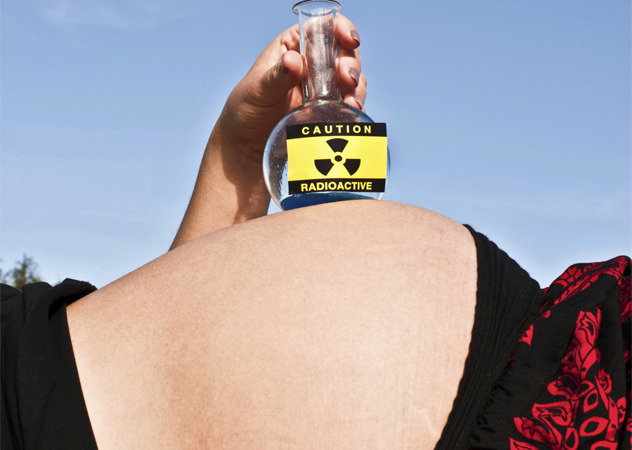 Crime
Crime  Crime
Crime  Technology
Technology 10 Hilariously Over-Engineered Solutions to Simple Problems
 Miscellaneous
Miscellaneous 10 Ironic News Stories Straight out of an Alanis Morissette Song
 Politics
Politics 10 Lesser-Known Far-Right Groups of the 21st Century
 History
History Ten Revealing Facts about Daily Domestic Life in the Old West
 Weird Stuff
Weird Stuff 10 Everyday Products Surprisingly Made by Inmates
 Movies and TV
Movies and TV 10 Actors Dragged out of Retirement for One Key Role
 Creepy
Creepy 10 Lesser-Known Shapeshifter Legends from Around the World
 Animals
Animals 10 Amazing Animal Tales from the Ancient World
 Gaming
Gaming 10 Game Characters Everyone Hated Playing
 Crime
Crime 10 Terrifying Serial Killers from Centuries Ago
 Technology
Technology 10 Hilariously Over-Engineered Solutions to Simple Problems
 Miscellaneous
Miscellaneous 10 Ironic News Stories Straight out of an Alanis Morissette Song
Who's Behind Listverse?

Jamie Frater
Head Editor
Jamie founded Listverse due to an insatiable desire to share fascinating, obscure, and bizarre facts. He has been a guest speaker on numerous national radio and television stations and is a five time published author.
More About Us Politics
Politics 10 Lesser-Known Far-Right Groups of the 21st Century
 History
History Ten Revealing Facts about Daily Domestic Life in the Old West
 Weird Stuff
Weird Stuff 10 Everyday Products Surprisingly Made by Inmates
 Movies and TV
Movies and TV 10 Actors Dragged out of Retirement for One Key Role
 Creepy
Creepy 10 Lesser-Known Shapeshifter Legends from Around the World
 Animals
Animals 10 Amazing Animal Tales from the Ancient World
 Gaming
Gaming 10 Game Characters Everyone Hated Playing
10 Fascinating Experiments That Happened By Accident
Most of the time, science requires careful planning, intricate design, and billions of dollars. No one accidentally decodes the human genome or finds a Higg’s boson down the back of the sofa. But sometimes, the world conspires to create just the right conditions needed for the men and women in lab coats to gain a little more insight into how this whole reality thing operates. These are experiments that scientists stumbled across, already completed and ready to be analyzed.
10 Nuclear Bombs And Obesity

As everyone on the Internet knows, all body weight problems can be solved with one weird trick (but be careful, because doctors will hate you). An international team of scientists took this to heart when trying to figure out how quickly people gain and lose fat cells. When our weight changes, we don’t change our number of fat cells; they just empty or fill with differing amounts of fat. While the number stays the same, scientists wanted to know if we simply churned out new ones to replace cells that died, or if we kept the same cells forever.
To figure this out in animals, scientists use radioactive food. This results in radioactive DNA, and researchers can monitor how quickly this disappears from the body. For ethical reasons, and because of the risk of a zombie outbreak, scientists can’t get people to munch on the radioactive meals required to do this experiment. Luckily for the scientists, the US and Soviets already went to the trouble of irradiating all of the food everywhere during the 1950s with their nuclear tests, so the radioactive markers were already in place in people from that time.
By looking at the amount of radioactive carbon 14 in people born at various points both before the bomb tests and past their peak in the 1960s, the scientists were able to work out that we increase our number of fat cells up until our late teens. We then churn them out at a rate of around nine percent per year. Now you have that piece of knowledge, the Cold War probably seems worth it.
9 Georgia Land Lottery

If we were to randomly give you a big chunk of wealth, how well off would your children and grandchildren be? Unfortunately, that’s not the sort of experiment that’s easy to run. Aside from getting funding, it’d take a couple of generations to figure out anything meaningful.
The only way to answer that question is to find an example of someone that randomly distributed wealth to a whole bunch of people at some point in the past. Luckily for economists, the state of Georgia did just that in 1832. When the Georgian government stole a bunch of land from natives, they decided the fairest thing to do would be to put every white dude’s name in a hat and assign winners a plot at random (“fair” is a relative term here). For many, this would be a potentially life-changing event as the land was worth a lot.
Economists looked at all the people involved in this scheme, and found that getting a huge injection of wealth made no difference to schooling, literacy, occupation, or wealth in the children of the people that got land. Those that didn’t win anything in the land lottery sent their kids to school just as much, and those kids did the same things. Of course, Georgia in the middle of the 19th century was a very different place than it is now, so the same thing may not happen in the 21st century. Nevertheless, it shows that getting wealth is no guarantee that you’re going to improve life for your descendants.
8 Order Of Merit

If you get a bunch of students of equal ability, and randomly give half of them more academic recognition, will they do better? Lynch mobs of disgruntled parents are the main stumbling block for anyone trying to answer that question, so where could you find data that simulates this experiment all by itself? It turns out you just need to go on the basis that “sometimes people are having a bad day.”
You see, exams are a tricky thing. Ability plays a role, but sometimes the wind might have kept you awake all night and you won’t do your best. If examiners say that everyone getting above 80 percent on a test gets an A, then there are going to be a bunch of people with a 79 that might have hit the threshold on another day, and some 81-percenters that just happened to have enough extra coffee to make the grade when normally they might not.
A study published in 1960 took advantage of this. They looked at students who took an exam for a Certificate of Merit, and compared those near the threshold on each side. Those that just barely passed received newspaper coverage and had their names printed in a booklet that was distributed to universities. Scientists considered those close to the threshold to be randomly likely to be on either side. Luckily, it turned out that it seemed to make no difference to the future prospects of the examinees—those hypothetical pitchfork-wielding parents would’ve had nothing to complain about.
7 Game Shows

If you’re a university researcher and you want to measure the behavior of people in terms of their aversion to monetary risk, you’re going to run into a few limitations. You can’t place people’s actual assets under threat, and you probably don’t have the resources to dangle meaningful prizes in front of them. The game of life in the real world is a big complex mess, and everyone’s playing with different probabilities. Where can a scientist turn?
The answer is TV game shows. Everyone playing is facing the same odds, pretty much, and the things they’re playing to win could significantly change their lives (though perhaps not their children’s). One of the best in recent years (academically) is the game show Deal Or No Deal, described in one academic paper as having “such desirable features that it almost appears to be designed to be an economics experiment rather than a TV show.”
Some of the findings of studies into these shows have found that men are more likely to take a risk. Interestingly, the starting wealth of a person doesn’t appear to have any impact on how likely they are to take a risk rather than settle for an assured amount. It also turns out that, in general, people are more likely to take greater risks when they’ve recently had an unlucky streak. Researchers speculate that this is because people are trying to get back to the point they were at before and will take increasingly greater gambles to do so.
6 Minnesota Twin Study

While perhaps less fun than “nature versus robots,” one of the timeless questions of the human condition is how much of our personality is the result of “nature versus nurture.” One way to figure out the relative influence of these two things is to create an army of clones and put them in differing situations. Sadly, that’s not been done, but the next best thing is studying identical twins that were adopted into different families as infants.
The Minnesota Twin Study is a famous example of this. Starting in the late 1970s, researchers began investigating the differences and similarities between twins who were separated early. What they found is that the twins were very likely to be alike in their personalities, interests, and attitudes. In fact, the twins were as similar as those that grew up together.
Other studies have found that homosexuality appears to have more genetic basis in males than females, as separated male twins are more likely to both be gay than female twins. A Swedish twin study into tobacco consumption also found a genetic component on likelihood to smoke, which also manifested more commonly in men.
5 Polynesian Islands

What would happen if you took a society of people, then divided them up and stuck them all in a bunch of different places with varying resources? Humans have been displacing each other’s civilizations for centuries, and many of the reasons are probably less reasonable than academic curiosity. The natural experiment that allows us some insight into this question comes from the people of Eastern Lapita, whose culture settled the Polynesian Islands a few thousand years ago.
When researchers looked at the way the landscapes influenced the people, they discovered that those on the sparser, drier islands tended towards a society that was more violent and militaristic. On lusher islands, such as Hawaii, the ruling structure was more complex and the idea of a kingship was formed, which helped keep the more negative traits in check.
4 Foreign TV In Dictatorships

Tyrannical governments like to control information. It’s why China blocks so much of the Internet and North Korea only has its own state television. Any information coming in from the outside world has the potential to let the citizenry know exactly how awful they have it and how much better things could be. The German Democratic Republic, or East Germany, is one of those countries that made including the word “Democratic” in your name the international equivalent of “I’m not racist, but . . . ” They also played host to a natural experiment on the influence of outside media.
Many West German television signals traveled into East Germany, so those living under the communist regime were able to watch foreign programs. However, the locations of the broadcasting towers, combined with the geography of the country, meant there were certain parts of East Germany that didn’t get any signal and were entirely reliant on internal media. Conventional wisdom would suggest that those people able to watch the outside television would be more prone to unrest.
It turned out that people were actually happier living under the regime if they did have access to the television. The researchers suggest that people used the signals as a form of entertainment, and that this meant they had less reason to get frustrated with their circumstances. You can draw your own conclusions from the fact that we can be sedated under a crushingly oppressive regime as long as we still get to watch a few sitcoms now and then.
3 Sexually Transmitted Viruses

If you want to figure out different ways that disease can be transmitted, you can’t exactly design an experiment to test it. “Make people ill on purpose” is the sort of methodology most ethics committees would take issue with. So it’s not surprising that the first documented case study of an insect-borne virus being transferred through sex, rather than mosquito bite, came about by mistake.
There was no mystery as to how US biologist Brian Foy ended up with what he believed was the disease dengue—he was on a field mission in Senegal collecting mosquitoes and was bitten several times. Foy’s illness was relatively uninteresting by itself. Yet his wife Joy, a nurse, hadn’t left Colorado. The species of mosquito that transmits dengue doesn’t exist around there, so when she later developed the same symptoms, they realized there had to be another avenue of transmission.
Further research, along with a chance meeting with an expert on rare tropical disease, brought to light the idea that Foy had actually caught a very rare disease known as Zika, which is often mistaken for dengue. A battery of tests confirmed the new diagnosis. Since there was no way his wife could have caught Zika through the normal channels, they sought another explanation. With almost complete certainty, they landed on the conclusion that it was transmitted during sex when Foy returned from his trip. He reports that his wife “wasn’t happy with what happened.”
2 Upsalite

There are a lot of places where it’s important to keep things dry, the manufacture of drugs and electronics being two key examples. So it’s perhaps surprising that the world’s most efficient absorber of water was discovered entirely by accident. Although theorized, it was dubbed the “impossible material,” as many thought it couldn’t be created. Researchers at the University of Uppsala were scratching their heads (figuratively) over how they could prove the doubters wrong. As it turned out, the answer was to accidentally leave an experiment running over the weekend and see what was in the lab come Monday.
What the researchers found was a gel that had formed and which contained the material they’d been hoping for. Not only does it absorb water at a crazy rate—a single gram has a surface area of 800 square meters (8,600 sq ft) because of its microscopic pores—but it actually takes less energy to produce than the next best materials available. After a year of experimentation, they were able to fine-tune the process, which should have significant commercial applications.
1 Rubber Ducks

Tracking ocean currents can be quite tricky. The oceans are very big, and dumping things into them just to see what happens is generally frowned upon. The international shipping industry loses up to 10,000 containers each year by accident, however, and one container that fell into the Pacific Ocean in 1992 has made an impact on our understanding of the oceans like no other. That container was filled with 29,000 floating bath toys—red beavers, blue turtles, green frogs, and yellow ducks—and they ended up in some odd places.
The Friendly Floatees, as they’ve been dubbed, washed up in both Hawaii and Alaska. Some of them went north and moved through the Arctic, ending up in Scotland. In the other direction, some ended up on the coast of Australia. The ducks have informed oceanographers of the time it takes for circuits in ocean currents to complete a rotation, which we didn’t previously know. A couple thousand are likely still out there, so keep an eye out next time you’re at the beach.
Alan’s science experiments are always planned to perfection and dastardly.








